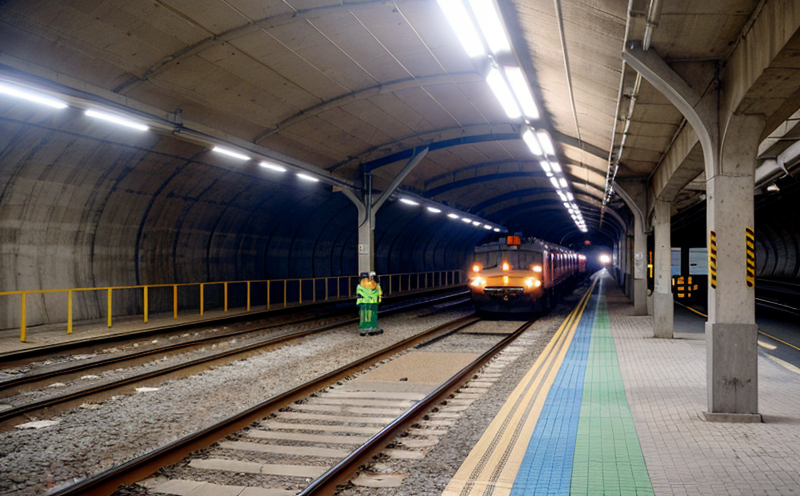EN 50155 Electronic Equipment Testing for Tunnel Installations
The European Standard EN 50155 is pivotal in ensuring that electronic equipment used in railway tunnel installations meets stringent safety and reliability requirements. This standard addresses the unique challenges faced by electronics operating in harsh, often subterranean environments where temperature fluctuations, humidity, vibration, and electromagnetic interference (EMI) are prevalent. The testing outlined in EN 50155 is designed to safeguard against failures that could compromise railway operations, passenger safety, or cause significant disruptions.
Under this standard, electronic equipment must undergo a series of rigorous tests aimed at evaluating its ability to withstand the environmental conditions found within tunnels, including:
- Vibration testing
- Temperature cycling
- Moisture exposure and condensation resistance
- EMI immunity assessment
- Radiation hardening (optional for certain equipment types)
The tests are conducted to ensure that the electronic equipment can maintain its operational integrity, resist degradation due to environmental factors, and function correctly in the presence of EMI. This is crucial given that tunnel environments can be hostile to electronics, with fluctuating temperatures ranging from freezing cold to scorching hot, high humidity levels, and constant vibrations caused by train movements.
The testing process begins with a thorough review of the equipment’s design documentation, which includes verifying compliance with EN 50155. Once approved, the equipment is subjected to various environmental conditions in controlled laboratory settings. This ensures that any issues are identified early on during development rather than later when they could be more costly and difficult to rectify.
Following testing, a detailed report summarizing all test results is generated. This includes data from each individual test conducted, along with an overall assessment of the equipment’s suitability for use in railway tunnel installations. The report serves as critical documentation that supports compliance with regulatory requirements and enhances confidence among stakeholders regarding the reliability of the tested equipment.
Compliance with EN 50155 is not only a requirement for manufacturers but also ensures that the end-users, such as quality managers, procurement teams, and R&D engineers can make informed decisions about selecting suitable electronic equipment. By adhering to this standard, railway operators can trust that their chosen electronics will perform reliably in challenging environments.
Why It Matters
The importance of EN 50155 testing cannot be overstated, especially given the critical role electronic equipment plays in modern rail systems. In railway tunnels, where environmental conditions can vary dramatically and unpredictably, ensuring that all installed electronics are robust enough to function correctly is paramount.
Failure of electronic components within a tunnel could lead to severe consequences such as:
- Train malfunctions
- Safety hazards for passengers and personnel
- Significant delays in service operations
- Economic losses due to downtime and repairs
- Potential environmental impacts from equipment failures
By adhering to the stringent requirements set out by EN 50155, manufacturers and suppliers of electronic equipment can significantly reduce these risks. This not only enhances passenger safety but also contributes positively to the overall efficiency and reliability of railway operations.
The standard's emphasis on environmental robustness ensures that the electronics used in tunnels are capable of withstanding the unique challenges posed by their operational environment. This includes protection against extreme temperatures, moisture ingress, mechanical stress from vibrations, and interference from external electromagnetic fields.
Why Choose This Test?
- Comprehensive Coverage: Ensures equipment can function effectively in tunnel environments with a wide range of tests covering various aspects.
- Regulatory Compliance: Helps manufacturers meet the necessary standards required by regulatory bodies, enhancing market access and reputation.
- Enhanced Reliability: Identifies potential issues early in development, reducing risks during deployment.
- Promotes Safety: Protects passengers and personnel from hazards associated with faulty electronics.
- Economic Benefits: Minimizes downtime and operational costs by ensuring equipment reliability.
- Increased Efficiency: Optimizes railway operations through reliable performance of critical electronic components.
- Environmental Responsibility: Reduces the impact on the environment from potential failures in harsh conditions.
The EN 50155 testing process is designed to be a robust and comprehensive approach, ensuring that only the most resilient electronic equipment finds its way into tunnel installations. This not only upholds the highest standards of safety but also contributes significantly to the sustainability and efficiency of railway systems worldwide.
International Acceptance and Recognition
The EN 50155 standard is widely recognized across Europe and beyond, serving as a benchmark for electronic equipment used in railway tunnel installations. Its acceptance by regulatory bodies and industry stakeholders underscores its importance in ensuring the safety and reliability of such critical infrastructure.
Many countries outside Europe have adopted or are considering adopting EN 50155 due to its comprehensive approach to addressing environmental challenges faced by electronics in harsh environments. This standardization fosters a harmonized approach towards railway technology, promoting interoperability between different systems and ensuring that electronic equipment performs reliably regardless of geographical location.
The widespread adoption of EN 50155 also facilitates smoother international trade and collaboration within the railway industry. As more jurisdictions recognize the value of this standard, it becomes easier for manufacturers to export their products globally while maintaining consistent quality standards across diverse operational environments.





